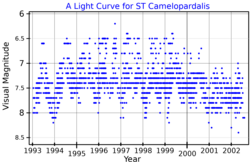ST Camelopardalis, abbreviated ST Cam, is a carbon star in the constellation of Camelopardalis. It has a radius of 244 R☉.[6]
| Observation data Epoch J2000.0 Equinox J2000.0 | |
|---|---|
| Constellation | Camelopardalis |
| Right ascension | 04h 051m 13.348s[2] |
| Declination | +68° 10′ 07.65″[2] |
| Apparent magnitude (V) | 6.3 to 8.5[3] |
| Characteristics | |
| Evolutionary stage | Carbon star |
| Spectral type | C5,4(N5)[3] |
| B−V color index | +2.1[4] |
| Variable type | SRb[3] |
| Astrometry | |
| Proper motion (μ) | RA: −2.992±0.136[2] mas/yr Dec.: −3.237±0.185[2] mas/yr |
| Parallax (π) | 1.6725 ± 0.0989 mas[2] |
| Distance | 2,000 ± 100 ly (600 ± 40 pc) |
| Absolute magnitude (MV) | −1.232[5] |
| Details | |
| Radius | 244[6] R☉ |
| Luminosity | 4,478[2] L☉ |
| Temperature | 3,388[6] K |
| Metallicity [Fe/H] | −0.1[7] dex |
| Other designations | |
| Database references | |
| SIMBAD | data |
In 1902, Thomas William Backhouse announced that ST Cam was a low amplitude variable star with a long or irregular period.[8] It was given its variable star designation in 1912.[9]
ST Cam is a semiregular variable star. It is doubly periodic, with the two pulsation periods P0 and P1 being equal to 368.6 and 201 days respectively.[10]
ST Cam is an AGB star, in the process of expelling its red giant envelope into space.[11] Line emission from the 115 GHz rotational transition of carbon monoxide was detected in 1987 by Olofson et al. The width of the emission line indicated that ST Cam is surrounded by a circumstellar envelope expanding at 10 km/sec.[12] Bergeat and Chevallier (2005) analyzed later molecular spectroscopy results, and derived an envelope expansion velocity of 9 km/sec, and a mass loss rate of 1.1 × 10−6 M☉ per year.[11] Broadband emission from dust in the envelope was spatially resolved by the IRAS satellite in its 60 micron data. Dust was detected out to a distance of 3.1 arc minutes from the star, or about 1.8 light years assuming a distance to ST Cam of 600 pc.[13]
References
edit- ^ "Download Data". aavso.org. AAVSO. Retrieved 1 October 2021.
- ^ a b c d e f Brown, A. G. A.; et al. (Gaia collaboration) (August 2018). "Gaia Data Release 2: Summary of the contents and survey properties". Astronomy & Astrophysics. 616. A1. arXiv:1804.09365. Bibcode:2018A&A...616A...1G. doi:10.1051/0004-6361/201833051. Gaia DR2 record for this source at VizieR.
- ^ a b c N. N. Samus; O. V. Durlevich; et al. "ST Cam database entry". Combined General Catalog of Variable Stars (GCVS4.2, 2004 Ed.). CDS. Retrieved 2018-10-14.
- ^ Ita, Y.; Matsuura, M.; Ishihara, D.; Oyabu, S.; Takita, S.; Kataza, H.; Yamamura, Issei; Matsunaga, N.; Tanabé, T.; Nakada, Y.; Fujiwara, H.; Wada, T.; Onaka, T.; Matsuhara, H. (2010). "AKARI's infrared view on nearby stars. Using AKARI infrared camera all-sky survey, 2MASS, and Hipparcos catalogs". Astronomy and Astrophysics. 514: A2. arXiv:1003.1130. Bibcode:2010A&A...514A...2I. doi:10.1051/0004-6361/200913695. S2CID 56323280.
- ^ Gontcharov, G. A. (2017). "VizieR Online Data Catalog: Tycho-2 red giant branch and carbon stars (Gontcharov, 2011)". VizieR On-Line Data Catalog. Bibcode:2017yCat..90370769G.
- ^ a b c Stassun K.G.; et al. (October 2019). "The revised TESS Input Catalog and Candidate Target List". The Astronomical Journal. 158 (4): 138. arXiv:1905.10694. Bibcode:2019AJ....158..138S. doi:10.3847/1538-3881/ab3467. S2CID 166227927.
- ^ Lambert, David L.; Gustafsson, Bengt; Eriksson, Kjell; Hinkle, Kenneth H. (1986). "The Chemical Composition of Carbon Stars. I. Carbon, Nitrogen, and Oxygen in 30 Cool Carbon Stars in the Galactic Disk". The Astrophysical Journal Supplement Series. 62: 373. Bibcode:1986ApJS...62..373L. doi:10.1086/191145.
- ^ Backhouse, T. W. (April 1902). "Confirmed or new variable stars". The Observatory. 25: 167–168. Bibcode:1902Obs....25..167B. Retrieved 3 November 2024.
- ^ "Benennung von neu entdeckten veränderlichen Sternen". Astronomische Nachrichten. 191 (19): 341. June 1912. Bibcode:1912AN....191..341.. doi:10.1002/asna.19121911902. Retrieved 3 November 2024.
- ^ Howarth, J. J.; Greaves, J. (February 2001). "ST Camelopardalis: A doubly periodic semiregular variable star". Journal of the British Astronomical Association. 111: 40–42. Bibcode:2001JBAA..111...40H. ISSN 0007-0297.
- ^ a b Bergeat, J.; Chevallier, L. (January 2005). "The mass loss of C-rich giants" (PDF). Astronomy and Astrophysics. 429: 235–246. Bibcode:2005A&A...429..235B. doi:10.1051/0004-6361:20041280. Retrieved 3 November 2024.
- ^ Olofsson, H.; Eriksson, K.; Gustafsson, B. (September 1987). "CO (J=1-0) observations of bright carbon stars". Astronomy and Astrophysics. 183: L13–L16. Bibcode:1987A&A...183L..13O. Retrieved 3 November 2024.
- ^ Young, K.; Phillips, T. G.; Knapp, G. R. (June 1993). "Circumstellar Shells Resolved in the IRAS Survey Data. I. Data Processing Procedure, Results, and Confidence Tests". Astrophysical Journal Supplement. 86: 517–540. Bibcode:1993ApJS...86..517Y. doi:10.1086/191789. Retrieved 3 November 2024.
